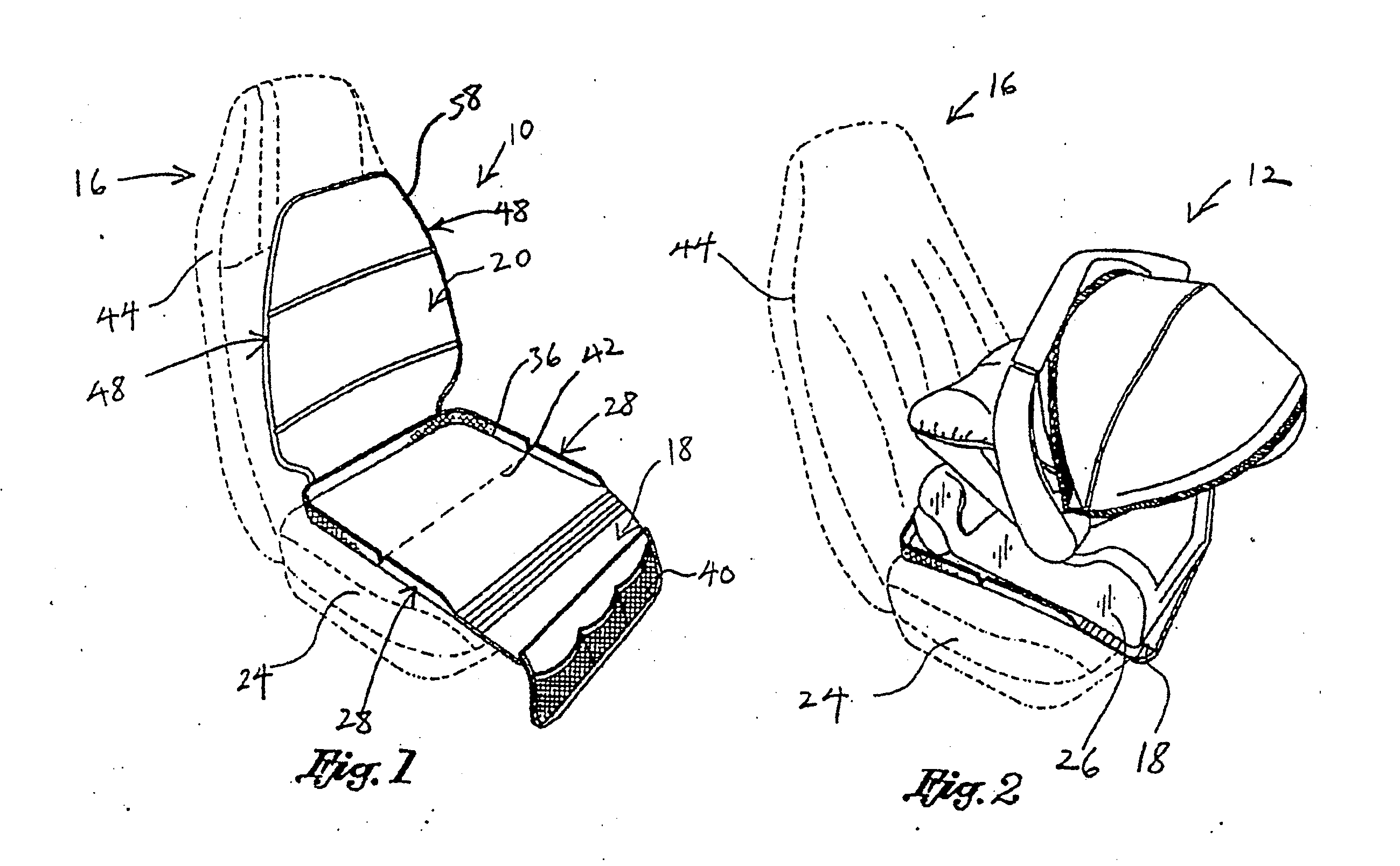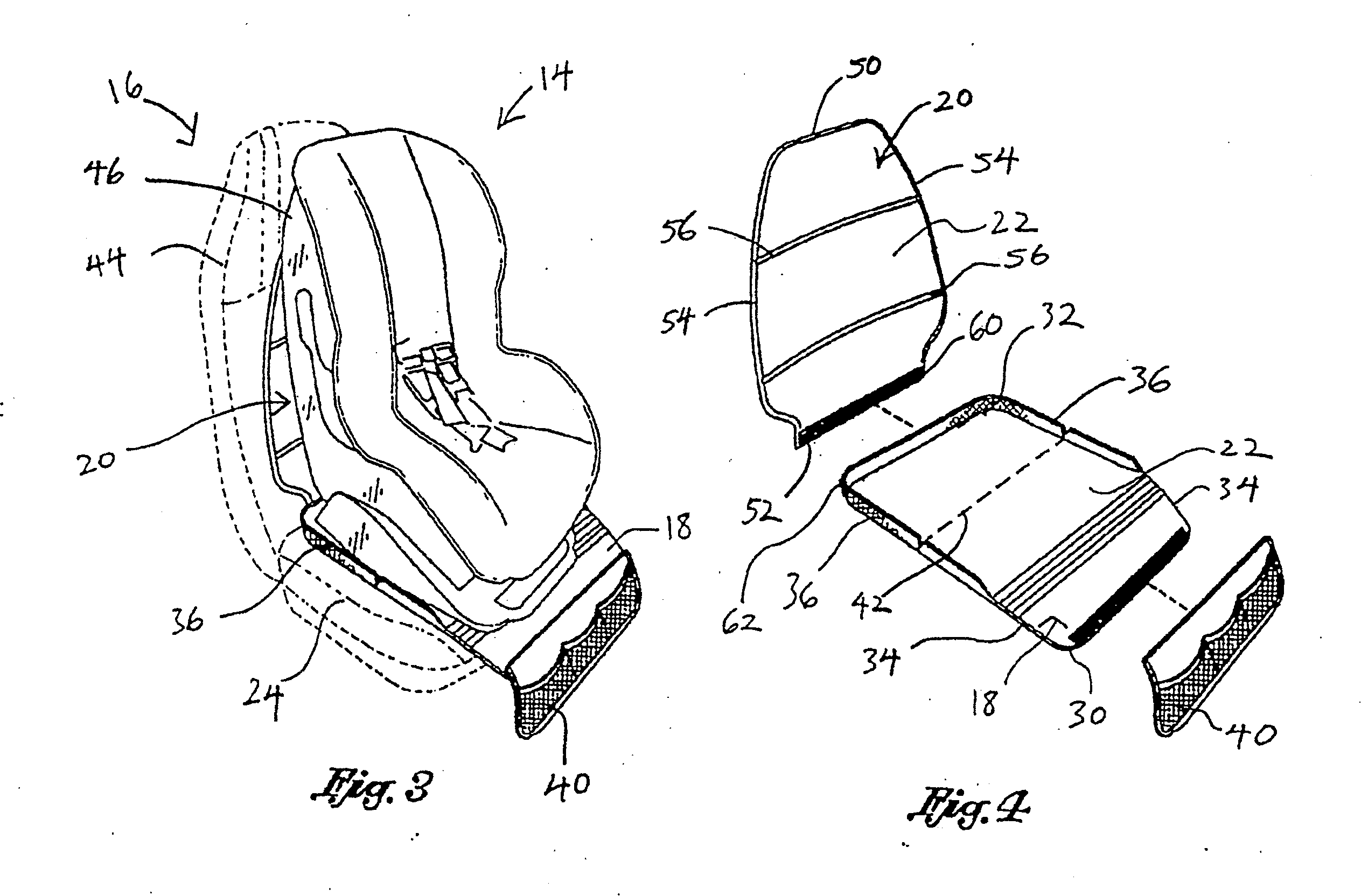[0012] The present invention specifically addresses and alleviates the above-referenced deficiencies associated with the use of the seat coverings of the prior art. More particularly, the present invention is an improved, two-stage seat cover which may easily alternate between one-piece and two-piece configurations so as to accommodate both rear and forward facing child safety chairs. As will be demonstrated below, the present seat cover's adaptability to transition between such configurations allows an infant and / or child to be safely carried within a vehicle, while preventing the vehicular seats from being damaged by accidental soiling or permanent compressions caused by the weight-bearing child safety chairs.
[0013] In accordance with a preferred embodiment of the present invention there is provided a two-stage seat cover for preventing a vehicular seat from being soiled or permanently deformed by a child safety chair which continuously applies its weight thereupon. The seat cover of the present invention comprises a lower rigid / semi-rigid protective member which is disposable upon a seating portion of the vehicular seat. The lower protective member is specifically designed for accommodating a rearward-facing safety chair as it is solely the chair's base section that contacts and thus applies weight to the seat at the seating portion. By using the lower protective member between the safety chair and the seating portion, the weight of the chair is distributed over the entire surface area of the protective member to thereby reduce any force generated by the weight from deforming the seating portion. Hence, the seating portion is prevented from suffering any permanent compression deformation.
[0016] In the preferred embodiment of the present invention, the seat cover also features an upper protective member which is selectively attachable to the lower protective member and is disposable against a seat-back portion of the vehicular seat. The upper protective member is specifically designed to be used in combination with the lower protective member for accommodating a forward-facing safety chair as it further applies its weight to the seat-back portion of the seat in addition to the seating portion. By providing the upper protective member when desired, the force generated by the weight of the forward-facing chair may similarly be more evenly distributed thereby so as to replace localized compression forces on the seat-back portion of the vehicle seat. Thus, the seat-back portion, as well as the seating portion, can be protected from becoming permanently deformed by the continuous weight imposed by the child safety chair.
[0017] The upper and lower protective members may be releasibly attached to each other through one of many known conventional methods. One of such preferred methods is employing the hook-and-loop fastening (commonly called Velcro). More specifically, a hook strip can be formed adjacent the upper bottom edge of the upper protective member, whereas a loop strip can be formed adjacent the lower rear edge of the lower protective member. However, one of ordinary skill in the art will recognize that an alternate arrangement may also be possible where the hook strip is defined adjacent the lower rear edge and the loop strip is defined adjacent the upper bottom edge. By utilizing this hook-and-loop arrangement, the upper protective member can easily and conveniently be attachable and detachable with respect to the lower protective member.
[0018] In operation, the present two-stage seat cover is used according to a child's growth progression for the purpose of accommodating a child safety chair upon a vehicular seat. As mentioned above, a parent typically utilizes the safety chair in a rearward-facing direction when his or her child is in the infant stage (i.e., below six months of age). To accommodate the rearward-facing safety chair, the parent may solely lay the lower protective member on the seat's seating portion such that the rearward-facing safety chair can be accommodated thereupon substantially within its formed ridge-like configuration. In this respect, the risk of permanent compression damage to the seating portion is significantly mitigated as the force generated by the chair's weight is more uniformly distributed by the lower protective member. Of course, any spillage originating from the safety chair will be contained within the vertical barrier formed by the lower member's ridge configuration.
[0019] When the infant matures in age and weight (i.e., six months up to eight years or eighty pounds in weight), the child safety chair must be turned around so that it now faces the front of the vehicle. In order to further prevent the weight of the forward-facing chair from being directly applied to the seat's seat-back portion, the upper protective member is disposed therebetween. More particularly, the upper member's hook strip can be abutted to the lower member's loop strip for releasible attachment between the upper and lower protective members. By doing so, further weight applied to the seat-back portion by the forward-facing chair is sufficiently distributed by the upper protective member so as to protect against permanent compression damage.
 Login to View More
Login to View More 


